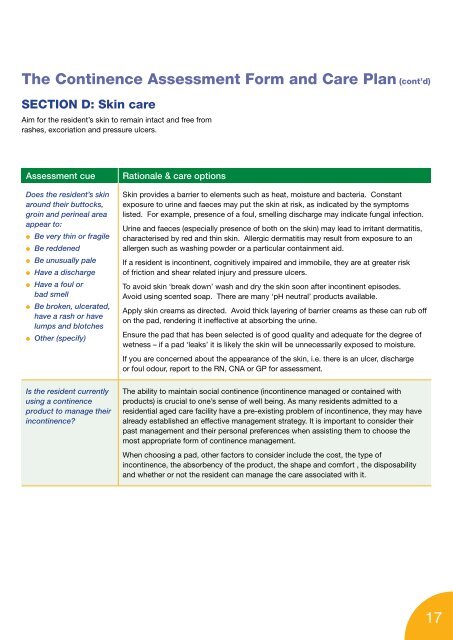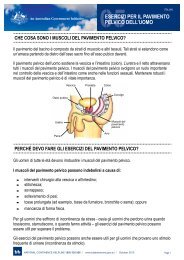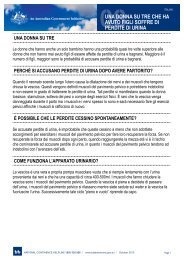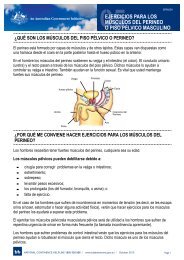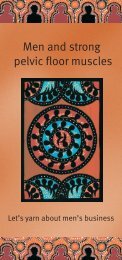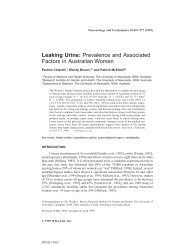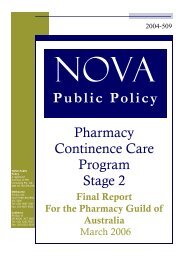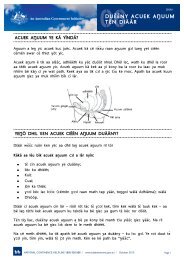Continence Tools for Residential Aged Care - Bladder and Bowel ...
Continence Tools for Residential Aged Care - Bladder and Bowel ...
Continence Tools for Residential Aged Care - Bladder and Bowel ...
Create successful ePaper yourself
Turn your PDF publications into a flip-book with our unique Google optimized e-Paper software.
The <strong>Continence</strong> Assessment Form <strong>and</strong> <strong>Care</strong> Plan (cont’d)<br />
SECTION D: Skin care<br />
Aim <strong>for</strong> the resident’s skin to remain intact <strong>and</strong> free from<br />
rashes, excoriation <strong>and</strong> pressure ulcers.<br />
Assessment cue Rationale & care options<br />
Does the resident’s skin<br />
around their buttocks,<br />
groin <strong>and</strong> perineal area<br />
appear to:<br />
● Be very thin or fragile<br />
● Be reddened<br />
● Be unusually pale<br />
● Have a discharge<br />
● Have a foul or<br />
bad smell<br />
● Be broken, ulcerated,<br />
have a rash or have<br />
lumps <strong>and</strong> blotches<br />
● Other (specify)<br />
Is the resident currently<br />
using a continence<br />
product to manage their<br />
incontinence?<br />
Skin provides a barrier to elements such as heat, moisture <strong>and</strong> bacteria. Constant<br />
exposure to urine <strong>and</strong> faeces may put the skin at risk, as indicated by the symptoms<br />
listed. For example, presence of a foul, smelling discharge may indicate fungal infection.<br />
Urine <strong>and</strong> faeces (especially presence of both on the skin) may lead to irritant dermatitis,<br />
characterised by red <strong>and</strong> thin skin. Allergic dermatitis may result from exposure to an<br />
allergen such as washing powder or a particular containment aid.<br />
If a resident is incontinent, cognitively impaired <strong>and</strong> immobile, they are at greater risk<br />
of friction <strong>and</strong> shear related injury <strong>and</strong> pressure ulcers.<br />
To avoid skin ‘break down’ wash <strong>and</strong> dry the skin soon after incontinent episodes.<br />
Avoid using scented soap. There are many ‘pH neutral’ products available.<br />
Apply skin creams as directed. Avoid thick layering of barrier creams as these can rub off<br />
on the pad, rendering it ineffective at absorbing the urine.<br />
Ensure the pad that has been selected is of good quality <strong>and</strong> adequate <strong>for</strong> the degree of<br />
wetness – if a pad ‘leaks’ it is likely the skin will be unnecessarily exposed to moisture.<br />
If you are concerned about the appearance of the skin, i.e. there is an ulcer, discharge<br />
or foul odour, report to the RN, CNA or GP <strong>for</strong> assessment.<br />
The ability to maintain social continence (incontinence managed or contained with<br />
products) is crucial to one’s sense of well being. As many residents admitted to a<br />
residential aged care facility have a pre-existing problem of incontinence, they may have<br />
already established an effective management strategy. It is important to consider their<br />
past management <strong>and</strong> their personal preferences when assisting them to choose the<br />
most appropriate <strong>for</strong>m of continence management.<br />
When choosing a pad, other factors to consider include the cost, the type of<br />
incontinence, the absorbency of the product, the shape <strong>and</strong> com<strong>for</strong>t , the disposability<br />
<strong>and</strong> whether or not the resident can manage the care associated with it.<br />
17


